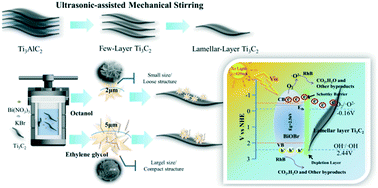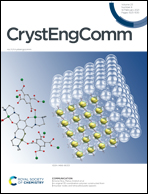BiOBr/Ti3C2 nanocomposites prepared via an octanol solvothermal method to achieve enhanced visible photocatalytic properties†
Abstract
BiOBr nanospheres grown in situ on lamellar Ti3C2 were synthesised in an octanol solvothermal system to obtain BiOBr/Ti3C2 heterojunction composites with high visible photocatalytic activity (OBT). The composition, crystal structure and morphology of OBT were characterised using X-ray diffraction, X-ray photoelectron spectroscopy and transmission electron microscopy. The photoelectrochemical properties of OBT were tested via UV-vis diffuse reflectance spectroscopy (DRS), electrochemical impedance spectroscopy and transient photocurrents. Results showed that the BiOBr prepared with octanol demonstrates loose nanospheres with a diameter of approximately 2 μm and clear characteristic peak intensity of the (110) crystal plane. Compared with pure-phase BiOBr and BiOBr/Ti3C2 heterojunction synthesis with an ethylene glycol solvothermal method (EBT), the increased visible-light response threshold of the OBT band gap and the significantly enhanced photogenerated current density of OBT effectively improve the oxidation efficiency of the aromatic ring structure. The rhodamine B degradation rate of OBT is approximately 10% higher than that of EBT. Trapping agent experiments confirmed the dominant role of ˙O2− in OBT photocatalytic processes. The results of this study can provide a basis for the analysis of the photocatalytic mechanism of OBT.

- This article is part of the themed collection: Nanomaterials


 Please wait while we load your content...
Please wait while we load your content...